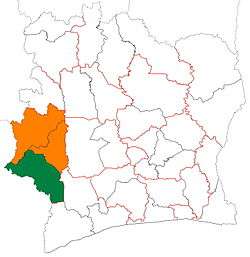Taï
| Taï | |
|---|---|
| Town, sub-prefecture, and commune | |
 Taï Location in Ivory Coast | |
| Coordinates: 5°52′N 7°27′W / 5.867°N 7.450°WCoordinates: 5°52′N 7°27′W / 5.867°N 7.450°W | |
| Country |
|
| District | Montagnes |
| Region | Cavally |
| Department | Taï |
| Population (2014)[1] | |
| • Total | 31,928 |
| Time zone | GMT (UTC+0) |
Taï is a town in southwestern Ivory Coast. It is a sub-prefecture of and the seat of Taï Department in Cavally Region, Montagnes District. Taï is also a commune. The town is between Taï National Park and the Cavally River. The river—which is the border with Liberia—is less than two kilometres south of the town. Previously, Taï was a sub-prefecture of the Guiglo Department; Taï Department was created on 22 March 2013.[2]
Climate
Taï's climate is hot and humid throughout the year with temperatures averaging around 26 °C. The climate is divided into four seasons:
- A long rainy season from March–April to mid-July when moist winds from the Atlantic Ocean cause numerous thunderstorms and heavy rainfall.
- A short dry season in mid-July to September where rainfall are rare, but the sky is heavily overcast.
- A small rainy season from September to November with little rain.
- A long dry season from December to February–March including a period in December that is characterized by a great freshness at night and in the morning, partly due to the northeast trade winds called Harmattan.
Politics and administration
The current prefect of Taï is Mr. Kouassi Aka Bio. The current sub-prefect of Taï is Mr. Gore Bi Zan Adolphe. The current mayor of the town of Taï is Mr. Gnonkonte Modeste.
Economy
The local economy is based primarily on plantation agriculture such as cocoa, coffee and rubber.
Ecotourism and sustainable tourism
Nature and culture: a community-based ecotourism project
Being at the gates of the famous Taï National Park, a community-based ecotourism project has been developed in the town that offers a range of activities based on nature and culture. The partners of this community based ecotourism and sustainable development project are the Wild Chimpanzee Foundation (WCF), the town of Taï, and the OIPR (Office Ivorien des Parcs et Réserves).
Ecomuseum
Built at the end of 2012 and opened in June 2014, the eco-museum, located at the entry of the town of Taï, acts as a reception center to accompany visitors throughout their stay in Taï and within Taï National Park. The eco-museum also offers a retrospective of 34 years of studies on the "nut-cracking" chimpanzees of Taï National Park. The building is meant to be a vector of transmission of the natural and cultural heritage of the region by raising awareness to young people and adults through presentations, diffusions of documentaries, fun and educational games and to actively support local crafts (exhibition and sale of handicrafts).
Taï National Park
Taï National Park, with an area of 5,400 km, is the last great forest blocks of primary tropical forest of West Africa. It is extended to the north by the N'Zo Wildlife reserve. Classified as a Biosphere Reserve in 1978 and as World Heritage Site in 1981 by UNESCO, Taï National Park has a high rate of endemism at both plants and animals level. More than 200 species of plants in the park are endemic for West Africa as well as important mammals such as pygmy hippopotamus, Jentink and Ogilby duikers, several species of monkeys unique for the region and nearly 24 species of birds. Taï National Park is also home to one of the largest population of chimpanzees,[3] in West Africa (Pan troglodytes verus) famous for their unique behaviour that make them a special population interesting scientifically and valuable for conservation.
The majority of the territory of Taï sub-prefecture is located within the boundaries of the park.
Nearby cities
Nearby villages
South:
- Kouadiokro
- Gouléako 1 ou Trois Cailloux
- Gouléako 2
- Pauléoula
- Diéré-Oula
- Port-Gentil
- Tiéolé-Oula
- Sakré
- Ziriglo
North:
- Daobly
- Ponan
- Gahably
- Zaïpobly
- Kéïbly
- Djidoubaye
- Goulégui-Bèouè
- Tienkoula
- Vodelobly
In Liberia (on the other side of the border):
- Tempo (west)
Twin towns
Taï is twinned with:
External links
- (en) The official website of the Wild Chimpanzee Foundation (WCF): http://www.wildchimps.org/
- (fr) The official website of OIPR (Office Ivoirien des Parcs et Réserves): http://www.oipr.ci/
References
- ↑ "Côte d'Ivoire". geohive.com. Retrieved 10 December 2015.
- ↑ "La sous-préfecture de Taï érigée en chef-lieu de département". abidjan.net. 2013-03-22.
- ↑ Kormos and Boesch (2003). Regional Action Plan for Chimpanzees in West Africa. Washington: Conservation International.
- ↑ "annuaire des mairies de France". La ville de Lure.
